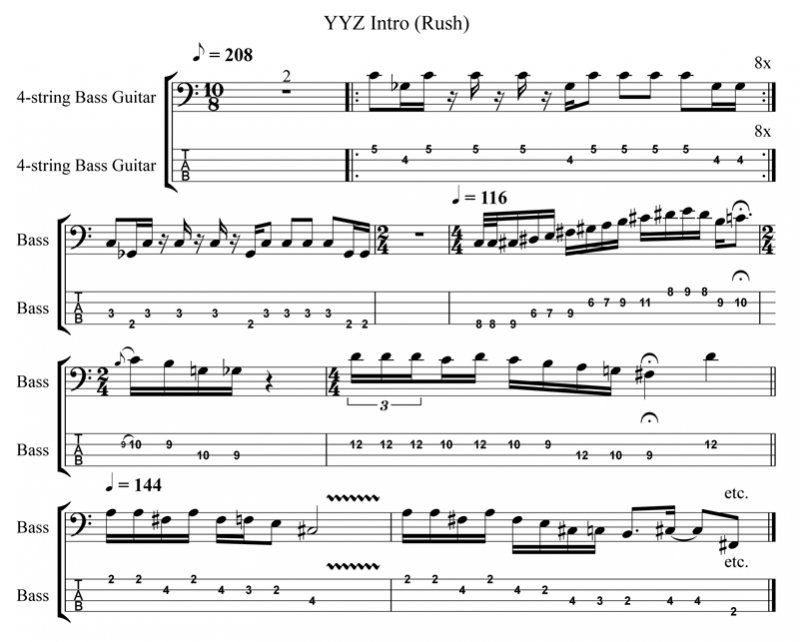Deep Thinking: YYZ – The Prog Rock of Rush
Deep Thinking: YYZ – The Prog Rock of Rush
The last few Deep Thinking columns have been funk-orientated, so I thought we might get into some prog rock in this issue and I have transcribed the opening of YYZ by the Canadian band, Rush.
This track comes from their 1981 album ‘Moving Pictures‘ and, unlike most of the band’s material, it is an instrumental. YYZ is the international code for Toronto airport, which is the band’s hometown. I was there a few years ago and kept my YYZ baggage tag. (Okay, I know I’m sad!)
Anyway, the piece opens with two bars of drums followed by a diminished fifth (flat 5) interval played between C and Gb in a 10/8 metre that is actually the Morse code pattern for ‘YYZ’. After playing it eight times on strings 1 and 2, the same figure drops an octave for the ninth bar on strings 3 and 4. Therefore, you could use fretting fingers 4 and 3 for the first eight bars and then 2 and 1 for the lower octave.
After a 2/4 bar rest, there is a 4/4 bar that is probably the trickiest in the entire piece. If you follow the tablature, it can be played starting with fretting finger 3 on C natural at fret 8, string 4 (demisemiquavers –– fast!) and then finger 4 on C# at fret 9. In this way, you can then play D# with finger 1 on string 3, E with finger 2 and F# with finger 4. The G# is fretted by finger 1 on string 2, A by finger 2 and B by finger 4. You then slide finger 4 up to fret 11 on string 3 for the C#, which is followed by D#, E, D# on string 1 with fingers 1, 2 and 1.
The final two notes of the bar are, again, played on string 3 at frets 9 and 10 by fingers 2 and 3 – B to C natural, which is paused. The next bar is also in 2/4 metre with an appogiatura (squeezed in) B rising to C in the same place before you move downwards through B, G and Gb all around frets 9 and 10 fretted by fingers 1 and 2.
Moving back into 4/4 metre, we move up to fret 12 on string 2 for a group of triplet semiquaver Ds that are followed by C natural at fret 10 going back up to D before a downward phrase of C, B, A, G on frets 10, 9, 12 and 10. You then pause with finger 1 on F# at fret 9, string 3, which is followed by D at fret 12, fretted by finger 4.
 At this point, the first main section of the piece begins. Move down to the lower part of the neck with finger 1 fretting A at fret 2, string 1. Finger 3 frets F# at fret 4, then frets another A on string 1 with finger 1 before the line moves downwards through F#, F natural and finally ends with a minim E, which has a slight bend (thats what the wiggly line means). The next bar is similar but moves downwards through C# and C natural before a B, C# and F# phrase, which is again fretted by fingers 1 and 3.
At this point, the first main section of the piece begins. Move down to the lower part of the neck with finger 1 fretting A at fret 2, string 1. Finger 3 frets F# at fret 4, then frets another A on string 1 with finger 1 before the line moves downwards through F#, F natural and finally ends with a minim E, which has a slight bend (thats what the wiggly line means). The next bar is similar but moves downwards through C# and C natural before a B, C# and F# phrase, which is again fretted by fingers 1 and 3.
There are several versions of YYZ on Youtube but make sure you check out a live version as well, the band is impressive. I’ll transcribe what follows for the next issue of NZM.
Dr. Rob Burns is an Associate Professor in Music at the University of Otago in Dunedin. As a former professional studio bassist in the UK, he performed and recorded with David Gilmour, Pete Townsend, Jerry Donahue, Isaac Hayes, Sam and Dave, James Burton, Ian Paice and Jon Lord, Eric Burdon and members of Abba. He played on the soundtracks on many TV shows, such as Red Dwarf, Mr. Bean, Blackadder, Not the Nine OClock News and Alas Smith and Jones. Rob is currently a member of Dunedin bands Subject2change and The Verlaines.
